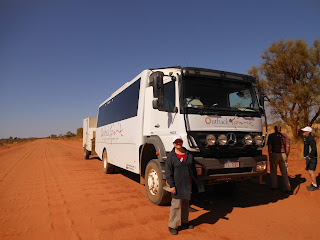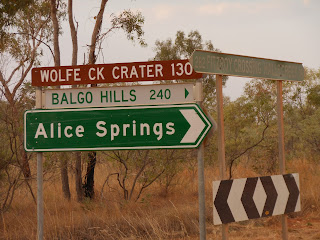Termite mounds abound, mostly small but some are rather large lumps. At one spot they looked like a field of stelae, reminding me of my visit to Tunisia. Even I of little imagination could see things in them, lots of animals, of course, but one was a dead ringer for a terracotta warrior.
There's not a lot of wildlife to be seen – as sparse as the cattle of the area. But there have been the odd sightings of camel, kangaroo, brumbies, wedge-tail eagles, kites, a few colourful birds (blue-winged kookaburras, Major Mitchells, rainbow lorikeets and budgerigars amongst them). The stand-out stunner (so far) has been the red-winged cockatoo, with its, yes, red wings!, green body and black contrast. Plus a dingo, wandering about the Purnululu campsite after dark!
There are many more wildflowers to be seen, compared to when I was in Central Australia in May. But it's hardly a riot of colour as might be expected in other climates. So many Australian wildflowers are tiny. But beautiful and delicate when you get up close to them.
It says something about the Tanami that a fuel storage tank can be remarked upon, And the bus got a laugh when a tin shed with wind sock nearby was described as “Coyote [Mine] International and Domestic Terminal”.
One thing that gave me a thrill was stopping at the northern end of the Canning Stock Route at Bililuna. I have vague memories of learning a bit about it at school but more recently, thanks to my friend Pamela who found it at her workplace in a secondhand/antiquarian bookshop in Stamford, England, and sent it to me, I read a book about, and with large swathes by, Canning's 2IC, H.S. Trotman. Absolutely fascinating. Some of it grim, some of it dreadful, especially in the way Aboriginals were treated.
 |
Me on the Tanami Road
|
 |
| Morning tea stop |






